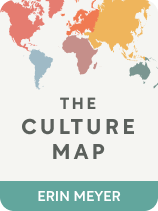

This article is an excerpt from the Shortform book guide to "The Culture Map" by Erin Meyer. Shortform has the world's best summaries and analyses of books you should be reading.
Like this article? Sign up for a free trial here .
How do you measure cultural differences? In what key ways do the world’s cultures differ?
In an increasingly globalized world, understanding different cultures is an essential business skill. However, there are few systematic methods for analyzing and dealing with specific cultural differences. To address this gap, cultural communication expert Erin Meyer developed an eight-dimension framework for mapping cultural differences.
In this article, we’ll look at Erin Meyer’s culture map comprised of the eight axes of cultural difference.
The Eight Axes of The Culture Map
In her book The Culture Map, Erin Meyer presents eight axes you can use as a framework to analyze cultural differences: Communication, Feedback, Thinking, Leadership, Decision-Making, Trust, Disagreement, and Time Perception.
Communication: Meyer defines the two extremes of communication as high-context and low-context. Meyer defines low-context cultures as cultures where people communicate and receive messages at face value. The speaker explicitly states all relevant information because it’s her responsibility to communicate her message clearly. In contrast, high-context cultures don’t communicate at face value—rather, you read between the lines. These people share cultural understandings about etiquette, so the speaker doesn’t need to be explicit; the listener is responsible for decoding the underlying meaning.
Feedback: Meyer defines the two extremes of feedback, or evaluation, as direct and indirect negative feedback. According to Meyer, people from cultures that prize direct negative feedback state negative feedback clearly and explicitly. In contrast, Meyer states that cultures that use indirect negative feedback tend to deliver their messages in a subtler manner, often couching these messages in positive affirmations and using words to mitigate their feedback. But it’s so subtle that the receiver might not register the feedback as negative at all.
Thinking: Meyer divides how cultures think into two categories: holistic (or dialectical) and specific (or analytical). In cultures that think dialectically, people tend to focus on the overall situation. Instead of focusing on individual elements, they emphasize the relationships between individual elements. In cultures that think analytically, people tend to focus on the individual element or action. Unlike dialectical cultures, they de-emphasize the surrounding circumstances.
Leadership: Meyer contends that you can divide leadership styles into two extremes: egalitarian and hierarchical. In egalitarian cultures, everybody is equal—even in the workplace. Companies tend to have flat organizational structures, and people treat each other the same regardless of rank. Conversely, rank matters in hierarchical cultures. Companies have strict levels, which employees follow by deferring to the higher-ranking individual. In exchange for obedience, the boss protects and cares for her employees—especially in Asian cultures.
Decision-Making: Meyer suggests that decision-making styles range across two extremes: consensual (which we’ll call consensus) and top-down (which we’ll call individual). In countries that decide by consensus, the group takes everyone’s opinion into account. All the relevant parties consider all the information, and they make a decision only when everybody agrees. In countries that decide individually, the decision-maker may consider others’ opinions, but ultimately, the individual (usually the boss) makes the decision. These cultures tend to make decisions quickly and early in the process. But even after it’s made, the decision remains flexible and open to change based on new information or new opinions.
Disagreement: Meyer divides disagreement styles across two extremes: “confrontational” and “avoids confrontation.” According to Meyer, cultures that disagree openly view disagreement as good for the group. Disagreement is inevitable when ideas are freely exchanged, as they must be for innovation to occur. People disagree with you frankly and publicly, but these open disagreements aren’t viewed as personal attacks. In disagreement-avoidant cultures, openly disagreeing with someone will harm your relationship. Disagreement is bad for the group and is viewed as a personal attack because it causes people to lose face. In these cultures, people express disagreement subtly and privately.
Trust: Meyer divides trust-building methods into two extremes: task-based, which we’ll call cognitive, and relationship-based, which we’ll call personal. According to Meyer, in cognitive cultures, trust develops based on behavior—like whether someone’s good at their job. Business relationships remain professional and don’t bleed into personal connections. In contrast, the cornerstone of business relationships in personal cultures is affective or personal trust—the trust that people of all cultures feel towards their family and friends. So while people build relationships slowly, this connection lasts across jobs.
Time Perception: Meyer divides time perception, which she calls scheduling, across two extremes: linear-time, or monochronic, and flexible-time, or polychronic. According to Meyer, monochronic cultures value a fixed, linear schedule. These cultures focus on one thing at a time and value punctuality (although lateness is generally acceptable up to a point). They run on “clock time,” eating lunch at noon because it’s noon. By contrast, polychronic cultures work on several things at once, adhering to schedules only broadly. They run on “event time,” eating lunch when they’re hungry.
Meyer visually represents the eight axes in a “culture map.”
Meyer positions countries on each axis, each of which represents a range of possible behavior between two extremes. Each country’s position represents the midpoint of acceptable behaviors in that country, which Meyer contends is enough to account for both individual and regional differences within a country. (Shortform note: Meyer bases these positions on anecdotes and personal experience. Her lack of outside research may be due to the difficulty of empirically measuring cultural differences: Cultural factors would influence any study methodology, so the study would be flawed.)
By understanding both your own and another culture’s position on each axis, you can relate to each other better so that you can accomplish your business goals. You are also better able to evaluate others accurately: You learn which misunderstandings are due to cultural differences instead of incompetence. (Shortform note: The idea that you can’t evaluate a culture’s position on the axis independently is known as cultural relativity. Don’t confuse this with cultural relativism—“the ability to understand a culture on its own terms and not to make judgments using the standards of one’s own culture.”)

———End of Preview———
Like what you just read? Read the rest of the world's best book summary and analysis of Erin Meyer's "The Culture Map" at Shortform .
Here's what you'll find in our full The Culture Map summary :
- The eight axes you can use as a framework to analyze cultural differences
- How to better relate to those of another culture to accomplish business goals
- How the Vikings have more gender equality than we see today







Hi Darya,
This is an excellent article. It gives a close snapshot of the framework designed by Erin Meyer in simple wording. I am working on a school assignment. I wonder if you could let me use the image depicting the 8 scales of the framework i.e. Culture A and Culture B.
Regards,
Vishal